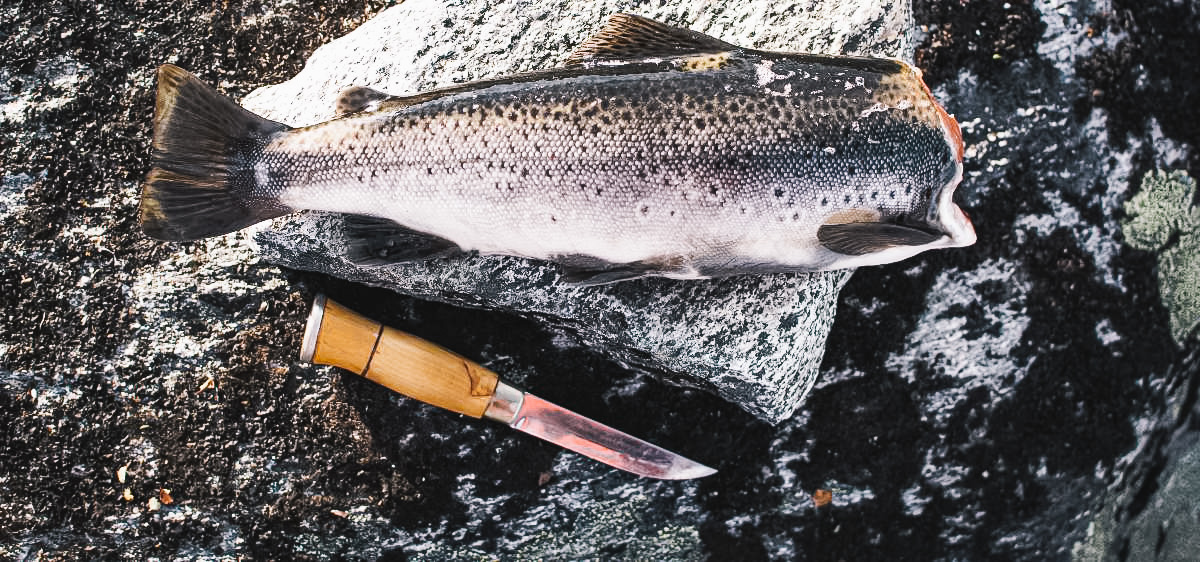Fishing is a classic pastime for many people, young and old. Whether you’re fishing for sport or for food, you’re going to need a sharp tool for the job. Determining the best fishing knife can be lots of fun, but it’s also quite challenging. With so many fishing knives to choose from, how can you be sure that the one you decide on is going to be up to the job?
Here’s our guide to the best fishing knives in the market in 2023.
BEST FISHING KNIVES 2023
- BUCK KNIVES 220BLS Silver Creek Folding Fillet Fishing Knife
- MORAKNIV Companion Fixed Blade Outdoor Knife
- KERSHAW Clearwater 9 Inch Fillet Knife
- CALAMUS Fishing Fillet Knife
- SMITH 7 WESSON Extreme Ops SWA24S
- RAPALA Fish n Fillet Superflex Knife
- KASTKING Fillet Knife 9 Inch
- GERBER Bear Grylls Folding Sheath Knife
- KERSHAW Blur Pocket Knife
- BUBBA 9 Inch Tapered Flex Fillet Knife
BEST FISHING KNIVES 2023
BUCK KNIVES 220BLS Silver Creek Folding Fillet Fishing Knife
General Impression
US-based Buck Knives has a stellar lineup of fishing, hunting, and general-purpose knives, but there is no doubt that their 220 Silver Creek Folding knife is the best fishing knife of 2023.
The 220 is a rather unique tool. As a fillet knife that folds into itself, it is easily stowed away in pockets, bags, or even in a belt holster. The convenience of the knife is certainly appealing, but so too is its general performance.
Every 220 undergoes the Bos treatment system, which involves heating, freezing, and reheating again. This creates an ultra-sharp and defined edge on the titanium nitride coated stainless-steel knife, allowing it to slice through countless mediums without any trouble.
Best of all – the handle is extremely comfortable, making cutting with the 6.5-inch blade a total breeze.
Specifications
BRAND: Buck Knives
KNIFE TYPE: Folding Fillet Knife
KNIFE LENGTH: 6.5 inches
KNIFE WEIGHT: 6 ounces
KNIFE MATERIAL: Titanium-Coated Stainless Steel
BLADE TYPE: Fillet Knife
BLADE LENGTH: 6.5 inches
BLADE THICKNESS: .075 inches
BLADE MATERIAL: Titanium-Coated Stainless Steel
PROS
- Made in the US
- Folds for easy transport
- Titanium-coated stainless-steel blade
- Thermoplastic rubber grip for comfort
CONS
- Water can become trapped in the folding mechanism
MORAKNIV Companion Fixed Blade Outdoor Knife
General Impression
European craftsmanship has long been revered by other continents, as the quality of goods crafted in the region is often finer than those found elsewhere. Hence why the Morakniv from Sweden is such a great bet, and no doubt the best fishing knife for the money.
The Morakniv is a multi-purpose Sandvik stainless-steel piece that can satisfy nearly any sportsman’s needs. It’s built in the traditional Scandinavian knife style, with a straight back and semi-thick width to ensure maximum power. At just 4 inches, the blade is somewhat short compared to other models, but it certainly doesn’t compromise the utility of the tool.
With all things considered, the Morakniv is a great general-purpose, saltwater, and fly fishing knife that anglers can rely on time and time again.
Specifications
BRAND: Morakniv
KNIFE TYPE: Fixed Blade Outdoor Knife
KNIFE LENGTH: 8.6 inches
KNIFE WEIGHT: 4.1 ounces
KNIFE MATERIAL: Sandvik Stainless-Steel
BLADE TYPE: Outdoor Knife
BLADE LENGTH: 4.1 inches
BLADE THICKNESS: .1 inches
BLADE MATERIAL: Sandvik Stainless-Steel
PROS
- Scandinavian style reinforced stainless-steel
- Comfortable handle grip
- Functions as a multipurpose knife
- Easy to sharpen
CONS
- The sheath is somewhat flimsy
KERSHAW Clearwater 9 Inch Fillet Knife
General Impression
The Kershaw Clearwater is a 9-inch fillet knife specifically designed to dice bait or clean fish. As a result, it is not super useful for cutting line or modifying tackle, but it is a great option to slice up baitfish and clean fresh catches.
What makes the product a competitive contender in the race to be the best saltwater fishing knife is its extended length, which allows it to cut into even sizable ocean fish. Smaller blades simply can’t cut as deep into such fish, thus making the process far timelier than it should. As a bonus, the handle is also quite comfortable.
In addition to this, the knife is crafted out of 420J2 stainless steel from Japan, which doesn’t fall victim to corrosion, rust, or oxidation like many of the carbon steel knives.
Overall, it doesn’t have the full utility that a pocket knife has, but there is no doubt that it is certainly a product that should be featured on any respectable fishing knife review.
Specifications
BRAND: Kershaw
KNIFE TYPE: Fillet Knife
KNIFE LENGTH: 14.25 inches
KNIFE WEIGHT: 3.53 ounces
KNIFE MATERIAL: 420J2 Stainless-Steel
BLADE TYPE: Fillet Knife
BLADE LENGTH: 9 inches
BLADE THICKNESS: NA
BLADE MATERIAL: 420J2 Stainless-Steel
PROS
- Great blade length at 9 inches
- Flexible and malleable for precision cutting
- Durable co-polymer handle
- High-quality ABS sheath
CONS
- Too long to be easily transported
CALAMUS Fishing Fillet Knife
General Impression
The electric blue color of the Calamus Fishing fillet knife is more than enough to grab an angler’s attention. Consequently, its performance is also well above average, making it a very strong competitor as the best bait knife.
Calamus’ version of a bait knife takes the form of a 9-inch stainless steel German blade, with a striking blue Teflon finish to prevent water stains or corrosion. It is then fitted with golf-style handles, that give anglers a firm grip when cutting fish or carcasses.
Where the product really stands out is its sheath, as it is created with slats to minimize water storage. This handy feature prevents the blade from acquiring corrosion in a humid sheath, as there is no possible way for humidity to remain inside of it.
Due to its generous length, teflon coating, and relatively sharp blade, the tool is likely the best saltwater bait knife currently on the market.
Specifications
BRAND: Calamus
KNIFE TYPE: Fillet Knife
KNIFE LENGTH: NA
KNIFE WEIGHT: NA
KNIFE MATERIAL: G4116 Stainless-Steel
BLADE TYPE: Fillet Knife
BLADE LENGTH: 9 inches
BLADE THICKNESS: NA
BLADE MATERIAL: G4116 Stainless-Steel
PROS
- Non-slip golf-grip handle
- G4116 German stainless-steel
- Blue Teflon finish preventing staining
- Slatted nylon sheath to prevent water storage
CONS
- Lacks flexibility
SMITH 7 WESSON Extreme Ops SWA24S
General Impression
The Extreme Ops from Smith & Wesson is a great example of a durable pocketknife that can be used for a myriad of purposes.
Smith & Wesson’s best fishing pocket knife is crafted with a 3.1-inch-high carbon stainless-steel blade that neatly folds into a compact folding position. The ultra-durable blade comfortably fits into a semi-hollow frame that allows moisture to quickly dissipate.
In addition, the knife also contains a serrated edge on a partial section, making it easy to cut through line, rope, or leader. As a result, Extreme Ops is likely the best serrated fishing knife for everyday fishing adventures.
Specifications
BRAND: Smith & Wesson
KNIFE TYPE: Pocket Knife
KNIFE LENGTH: 7.1 inches
KNIFE WEIGHT: 3.5 ounces
KNIFE MATERIAL: High Carbon Stainless-Steel
BLADE TYPE: Serrated
BLADE LENGTH: 3.1 inches
BLADE THICKNESS: NA
BLADE MATERIAL: High Carbon Stainless-Steel
PROS
- Serrated edge for cutting line
- Ergonomic handle design
- Simple opening/closing mechanism
- High-carbon stainless-steel blade
CONS
- Relatively short blade
RAPALA Fish n Fillet Superflex Knife
General Impression
Rapala certainly is not new to the fishing world, as the European brand has been offering great products to anglers for decades now. Consequently, its Fish n Fillet Superflex knife is a great option for anyone looking to clean fish quickly and efficiently.
Due to its leather sheath, Rapala’s model is likely not the best saltwater knife, but for pretty much all other purposes it is a great option. Every blade is crafted with a PTFE non-stick coating that ensures the blade slices through flesh with ease, while also simplifying the cleanup process. However, as the name suggests, the blade is extremely flexible, allowing handlers to contort it into multiple angles to suit the needs of any job.
Specifications
BRAND: Rapala
KNIFE TYPE: Fillet Knife
KNIFE LENGTH: NA
KNIFE WEIGHT: NA
KNIFE MATERIAL: PTFE Coated Stainless-Steel
BLADE TYPE: Fillet Knife
BLADE LENGTH: 6 inches
BLADE THICKNESS: NA
BLADE MATERIAL: PTFE Coated Stainless-Steel
PROS
- Extremely flexible and malleable
- PTFE non-stick coating to reduce drag
- Genuine wooden handle
- High-quality leather sheath
CONS
- Not dishwasher safe
KASTKING Fillet Knife 9 Inch
General Impression
This 9-inch fillet knife from KastKing is an incredible piece that slices through fish, flesh, and fruits with unrivaled ease.
KastKing’s premiere fishing knife is crafted out of G4116 German stainless steel that holds a razor-sharp edge, which is honed rather than sharpened. It is wildly important that handlers maintain the edge through honing, rather than trying to simply remove excess material and sharpen it.
Not only is the blade great, but so too is the handle grip. Every model is outfitted with a super-polymer grip to reduce slippage and prevent the knife from moving around in an angler’s hands.
Overall, the tool is a fantastic piece for cutting bait and cleaning large fish. It isn’t a great choice as a multipurpose knife, but it certainly does a great job doing what it was designed to do. And when partnered with a pair of fishing pliers, the tool is practically unstoppable at cleaning fish.
Specifications
BRAND: KastKing
KNIFE TYPE: Fillet Knife
KNIFE LENGTH: 14.8 inches
KNIFE WEIGHT: NA
KNIFE MATERIAL: G4116 Stainless-Steel
BLADE TYPE: Fillet Knife
BLADE LENGTH: 9 inches
BLADE THICKNESS: NA
BLADE MATERIAL: G4116 Stainless-Steel
PROS
- G4116 German stainless steel
- Super-polymer handle grip to reduce slippage
- Decently flexible
- Easily cuts fish, chicken, and beef
CONS
- Requires regular sharpening
GERBER Bear Grylls Folding Sheath Knife
General Impression
Few characters have entertained an audience as well as Bear Grylls in the past two decades. The British adventurer has scaled mountains, traversed deserts, and crossed canyons to demonstrate helpful survival skills. And although many of his stunts have been staged, he is still quite a remarkable person.
But his knife collection with Gerber is as real as it gets. And the folding sheath model is an incredibly handy fishing utility knife that can be used in practically any environment. It is crafted from high-carbon stainless steel and an ergonomic rubber grip placed inside of a mildew-resistant nylon sheath.
Performance-wise, the piece does exactly what any outdoorsman would expect. It easily cuts line with its serrated edge, slices through the flesh of fish, and quickly chews through rope. Although it is a bit short, it manages to accomplish any difficult task. Bear Grylls may be controversial – but there’s little to no controversy in his knife collection as they are truly excellent products.
Specifications
BRAND: Gerber
KNIFE TYPE: Folding Sheath Knife
KNIFE LENGTH: 8.5 inches
KNIFE WEIGHT: 4.3 ounces
KNIFE MATERIAL: High Carbon Stainless-Steel
BLADE TYPE: Serrated
BLADE LENGTH: 3.6 inches
BLADE THICKNESS: NA
BLADE MATERIAL: High Carbon Stainless-Steel
PROS
- Serrated edge to slice line, rope, and leader
- Well-designed belt sheath
- Ergonomic rubber grip
- Mildew-resistant materials
CONS
- Short blade length
KERSHAW Blur Pocket Knife
General Impression
The Blur pocketknife from Kershaw is a classic matte black knife equipped with plenty of radical innovations. The first (and most unique feature) the Blur has, which few other saltwater fishing knives have, is a diamond-like carbon coating on its exterior. The additional coating adds durability to the blade, while also serving as a barrier to prevent corrosion and rust.
Where the blade seems to fall a bit short, is its lack of a serrated edge. Such a feature is incredibly helpful when cutting line, leader, and rope, as the teeth eat right through the fibers. Although the Blur doesn’t offer a serrated edge, it makes up for it by going above and beyond on all other features. With a Trac-Tec handle, secure locking system, and SpeedSafe assisted opening system, the tool is anything but ordinary.
Specifications
BRAND: Kershaw
KNIFE TYPE: Pocket Knife
KNIFE LENGTH: 7.8 inches
KNIFE WEIGHT: 4.2 ounces
KNIFE MATERIAL: 1428N Sandvik Steel
BLADE TYPE: Smooth
BLADE LENGTH: 3.37 inches
BLADE THICKNESS: NA
BLADE MATERIAL: Diamond-Like Coating Over Stainless-Steel
PROS
- Trac-Tec grip for incredible handling
- Diamond-like carbon coating for increased blade strength
- Easily opened with one hand
- Reversible pocket clip for adjustable carrying
CONS
- No serrated edges
BUBBA 9 Inch Tapered Flex Fillet Knife
General Impression
Bubba’s signature red hue makes its products easy to spot, as the crimson color differentiates the brand from all others. However, when it comes to fishing knives, the brand differentiates its products with far more than just a color scheme.
The 9-inch tapered flex blade is a great example of a product striving to be the best saltwater fishing knife, as it is chocked full of innovative designs. The first, and likely most beneficial of those is the trigger grip that forms into a handle safety guard, which is designed to protect anglers’ hands when slicing through flesh.
The second, and slightly less noticeable feature, is the titanium nitride coating that lines the entirety of the 9-inch fillet blade. While the coating augments the durability of the piece, it also serves as a barrier to protect the blade from rust and corrosion.
At the end of the day, a saltwater angler really can’t go wrong with a 9-inch Bubba fillet knife, as the model makes slicing through baitfish and fresh catches an absolute breeze.
Specifications
BRAND: Bubba
KNIFE TYPE: Fillet Knife
KNIFE LENGTH: 15 inches
KNIFE WEIGHT: NA
KNIFE MATERIAL: Ti-Nitride Coated Stainless Steel
BLADE TYPE: Fillet Knife
BLADE LENGTH: 9 inches
BLADE THICKNESS: NA
BLADE MATERIAL: Ti-Nitride Coated Stainless Steel
PROS
- Titanium nitride coating
- Trigger grip for increased control
- Flexible blade for precision cutting
- Handle safety guards to prevent injury
CONS
- Too large for most freshwater fish
BEST FISHING KNIVES
Buyer's Guide
Material
A blade’s material is a critical aspect that simply cannot be overlooked when analyzing options. Some blades fare well in saltwater, where others tarnish in just moments. There are countless materials that blades can be made from, but the primary types found in the best fishing knives are stainless-steel and carbon steel.
Stainless-steel blades are blades crafted with a handful of different metallic elements, to create a blade that is extremely resistant to corrosion and the elements. Typically nickel, chromium, iron, and carbon can be found in each stainless-steel blade, to ensure that the elements don’t eat away at the surface or edges of the tool. While stainless-steel blades are certainly great for use around salt water, they fail to hold as sharp of an edge as carbon steel or other metallic variants.
Carbon steel knives, on the other hand, are far sharper and more flexible than stainless-steel, and are ideal for cutting through thick flesh. However, due to their lack of elements such as chromium, they are extremely susceptible to rust, corrosion, and general tarnish. Additionally, the general properties of carbon react with acidic foods, often transferring the metallic flavor into the food. While this is certainly an issue in the kitchen, it doesn’t truly apply as much to the general use of a fisherman’s knife to fillet and debone fish.
Finally, there are titanium knives. Such knives are extremely durable and impervious to rust. However, they are difficult to sharpen due to their unique composition. If done wrong, the blade can be seriously damaged in the process.
Design
There is a wide variety of knives available to anglers these days, and this is to satisfy the vast number of activities that require blades. The best knife for fishing by the creek likely isn’t the best knife for filleting fish, and vice-versa. Before ever settling on a knife, it is important to establish what it is going to be used for.
Although there are countless varieties available, two main styles of knives dominate the fishing industry. The first, which is likely extremely obvious, is the pocketknife.
Pocket knives for fishing are fast and convenient tools that greatly add to the fishing experience. Whether they are used to cut lines, split worms, or even gut fish, they are a reliable addition to your tools on deck and will simplify most angler’s tasks.
A fillet knife on the other hand, or fish gutting knife, is a variant used specifically to debone and fillet fish. They are often fairly long knives, with slightly curved edges to make cutting easier. However, they lack the portability and versatility of a pocketknife. Additionally, they aren’t great for cutting lines and are slightly inconvenient when it comes to handling them on a boat. For the most part, gutting knives are just good for cutting up bait or cleaning fish.
Portability
Not all knives for fishing can be easily transported, as some are simply too long or bulky. To combat this, anglers usually have a collection of different knives – each with its own designated purpose.
When it comes to portability, nothing beats the fishing pocket knife. Most models are small, lightweight, and fold up into a minuscule size for easy transport. For backwoods exploring, streamside fishing, or general angling, they are a great bet.
Fillet knives, on the other hand, are far less portable than their folding fishing knife counterparts. Most fillet knives are longer than seven inches, making them difficult to strap to a belt or fishing bag. Consequently, fillet knives are best kept in the boat, in a fishing backpack, or on the dock.
Maintenance
Just like any other tool in the garage, knives need attention and maintenance to keep them performing at their maximum potential.
However, some knives simply require more attention than others. Fillet knives need to be sharpened much more frequently than pocketknives. Similarly, pocketknives need to be cleaned and greased, whereas fillet knives rarely need such maintenance procedures.
To avoid fighting issues with maintenance, only use a good fishing knife for its designated purposes and try to refrain from using it outside of fishing trips.
BEST FISHING KNIVES
FAQs
What are the different types of fishing knives?
Fishing knives are a broad category, as there are a handful of sub-categories that fall into the all-encompassing group. However, for the sake of brevity, only the types of knives that are featured on this list will be discussed.
When most anglers think of the best fishing knives, they imagine sleek pocketknives that can easily be tucked away. This is pretty accurate in most cases, however, there are also a handful of knife varieties for cleaning and deboning fish.
Fillet and boning knives are two examples of just that, as both variants are specifically designed to cut into fish. Besides having a thinner and more flexible blade than boning knives, fillet knives also have a slightly curved edge to offer a constant initial edge. Boning knives are typically made with a straight back and slightly thicker blade, to offer more power when cutting through dense flesh.
Pocket knives, on the other hand, are much more versatile tools that can be used for a vast number of purposes. Not only can they cut fishing lines, worms, and leaders, but they also can be used to gut fish and clean the organs out. They don’t offer the precision of a fillet or boning knife, but they certainly make up for their shortcomings by being far more versatile.
How do I sharpen fishing knives?
Sharpening knives was once an extremely difficult and time-consuming task. Thankfully, that just isn’t the case anymore.
Regardless of whether an angler has invested in the best fishing knives money can buy, or low-end products – there will likely come a time when the blades need to be sharpened. In today’s world, there are a handful of ways to sharpen blades that can take just mere seconds or minutes.
The first and easiest way is to simply purchase an automatic sharpener. Automatic sharpeners consist of spinning stones in an internal mechanism that rotates to remove impurities from blades. Often, automatic sharpeners have a couple of slots, which sharpen blades in sequential order. After the blade is inserted into the final slot, it comes out just like new.
However, packing an electric sharpener just isn’t possible when out on the water. In such situations, anglers can rely on sharpening stones or rods. Sharpening stones require a flat surface, where anglers can draw the blade back and forth – by simply dragging the blade against the surface of the stone, a knife can become incredibly sharp. For this reason, they also aren’t super practical for a day out on the water.
Sharpening rods, on the other hand, are the most beneficial when actively fishing. To sharpen a blade, anglers only need to draw the blade against the rod in both directions to remove any impurities. Although it is the most convenient method, it forges the least sharp edge on a fisherman’s knife.
How do I prevent fishing knives from rusting or corroding?
The first step to preventing a tool from rusting is properly choosing a material that resists rust and corrosion. While this is a beneficial step, it isn’t enough to prevent damage to even the best of knives.
A reliable way to prevent a knife from rusting or corroding is to constantly rinse it with fresh water, then properly dry it off. Rust is a byproduct of iron oxide, so for a piece to rust, it must contain a certain amount of iron. While most knives contain some iron, not all do, such as tungsten and titanium models.
Nevertheless, most of the best fishing knives still contain an amount of iron, even if they are crafted from stainless steel. While the chromium in stainless steel is designed to create a barrier and prevent oxidization, it doesn’t always do a great job of that.
So as a general rule of thumb – rinsing off any and all tools with freshwater is simply a necessity after being out on the water for the day. If a tool does happen to rust, simply apply marine jelly to it, and let it sit overnight. Once morning rolls around, the rust will wipe right off with the marine jelly.
Do I need more than one fishing knife?
In an ideal world, every angler would have the best fishing pocket knife and best filet blade possible, to ensure that they would be well prepared for each possible obstacle.
With that being said, most anglers should own both a pocket and fillet knife, since their purposes are so different. Pocket knives are extremely handy for maintaining fishing lines, lures, and tackle, due to their tendency to have serrated edges.
Fillet knives, on the other hand, are great at cutting up baitfish and fish that will be consumed. Yet, they are not reliable tools for practically anything else, as they are only designed with one purpose in mind.
However, if forced with the choice between the two types, the pocketknife would likely be the best knife for fishing.
What materials are the best knives made from?
There is no single best material for knives to be made from, as each metallic variant has its own advantages and disadvantages.
For the most part, most quality knives are made from stainless-steel. Stainless-steel is comprised of a variety of elements, such as nickel, iron, and most importantly – chromium. The high percentage of chromium added into stainless-steel creates a protective bond around the iron and prevents the element from oxidizing and accumulating rust. As a result, stainless-steel knives have largely dominated the market due to their reliability.
Other reliable materials include titanium, tungsten, and carbon steel. However, carbon steel doesn’t fare well in saltwater, and can easily fall victim to corrosion and staining.
What is the best fishing knife?
The best fishing knife that is currently on the market is Buck Knives’ 220 Silver Creek folding knife.
The 220 Silver Creek is an incredibly unusual knife, as it is actually a pocket fillet knife that folds into itself. Unlike most other fillet knives, the 220 Silver Creek is incredibly easy to transport and carry from one location to another.
However, there is far more to like about the knife than just its portability. The 6+ inch blade is crafted from stainless-steel with a titanium nitride coating, that maximizes the tool’s durability. Each blade is then attached to a non-slip TPE rubber handle, that offers incredible comfort and grip. Whether cutting small panfish, or large ocean fish, the tool is more than capable of doing any job.
Reach Out
As always, we create our content with you, fellow adventurers, in mind. So, how’d we do? Did you find this informative? Did it help you make a decision? Did we miss anything? We’d love to hear from you below. Thanks for reading and we hope your next adventure is a great one!



































